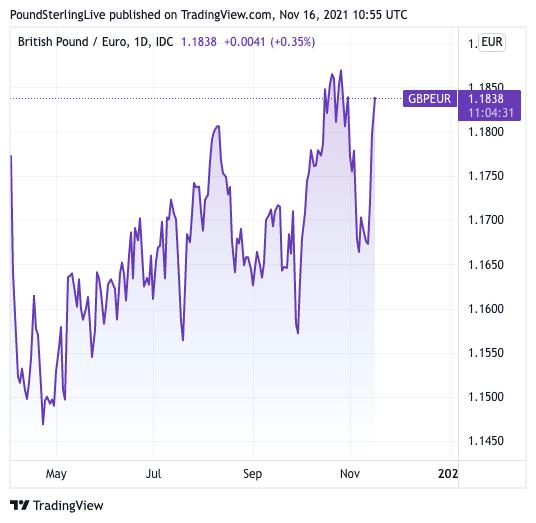Pound / Euro Rises Back Towards 2021's Best at 1.19
- Written by: Gary Howes
-

Image © Adobe Stock
The Pound to Euro exchange rate was seen making an approach on its 2021 best at 1.19 following the release of robust labour market statistics out of the UK.
Sterling was boosted across the board after official ONS data covering the September and October period showed employment continued to grow amidst strong demand for workers, with vacancies once again hitting a new record high.
Preliminary data for October revealed the number of employees on payroll rose by 4.0% compared with October 2020, a rise of 1,139,000 employees; there were 160K more people were in payrolled employment in October 2021 when compared with September 2021.
That there was no deterioration in the market following the end of the government's job support scheme in September will give the Bank of England confidence to raise interest rates in December or February 2022.
It is this building expectation that is aiding the Pound higher.
"GBP outperformed across the board. The UK September labour market report strengthens the case for the BoE to start normalising the policy rate in December. The money market and the median estimate of economists surveyed by Bloomberg already anticipate the BoE to lift the Bank Rate by 15bps to 0.25% on 16 December," says foreign exchange strategist Elias Haddad at CBA.
Above: GBP/EUR was seen on the approach to 2021 highs in the wake of UK labour market data.
- GBP/EUR rates at publication:
Spot: 1.1822 - High street bank rates (indicative band): 1.1508-1.1590
- Payment specialist rates (indicative band): 1.1716-1.1763
- Find out about specialist rates, here
- Or, set up an exchange rate alert, here
"The pound is surging on the back of Bailey’s remarks and better-than-expected UK employment figures, and is today’s best performer, rising by 0.3% against the greenback and 0.4% versus the euro," says Raffi Boyadjian, Lead Investment Analyst at XM.com.
The ONS reported employment grew 247K in the three months to September, surpassing the previous month's reading of 235K and analyst expectations for a reading of 185K to be delivered.
The unemployment rate fell to 4.3% in September, below the 4.4% expected by the market and August's 4.5%.
The average earnings index with bonuses included rose 5.8% in September, surpassing consensus estimates for 5.6%, although this was down on the surge of 7.2% recorded in August.
"This data speaks volumes about the strength of the jobs market. For months the drumbeat of job creation has been getting steadily louder, and it barely skipped a beat as the furlough scheme was ending," says Jack Kennedy, UK economist at Indeed.
The ONS said 15 out of the 18 industry sectors it follows recorded increases in job vacancies and in the three months to October there were a record 1.17 million jobs available.
"With both the number of people on payrolls and the number of vacancies now at records, from a workers’ perspective the data is especially rosy," said Kennedy.
{wbamp-hide start}
{wbamp-hide end}{wbamp-show start}{wbamp-show end}
"Yet another set of strong UK employment data and after November was a finely balanced decision to wait for said data, December now must be locked in," says a note from JP Morgan's foreign exchange dealing desk in London.
JP Morgan's desk have "dialled back" their more bearish view of the pound having recognised "we are in an increasingly tactical market here".
The jobs data followed new communication from Bank of England officials revealing concern about the UK's surging inflation levels, and that an interest rate rise could come at any upcoming Monetary Policy Committee (MPC) Meeting as a result.
Speaking to UK lawmakers on Monday Governor Andrew Bailey and three other MPC members said they would be more inclined to raise interest rates were labour market statistics to indicate there was no unemployment surge following the end of the government's furlough scheme.
The communication combined with Tuesday's data raises the odds of a December rate hike.
Haddad says the decline in the UK unemployment rate to 4.3% in the three months to September is tracking better than the Bank's projection of 4.4%.
"Record high job vacancies suggests labour market slack will continue to diminish at an encouraging pace," says Haddad.
The labour force participation rate meanwhile lifted 0.1 points to 63.4% which is the highest since December 2020.
"This morning's UK labour market data, and in particular the provisional estimate of a payroll employment for October, would seem to be the missing link needed to convince the MPC to rase rates in December," says Kit Juckes, FX strategist at Société Générale.
Juckes says having failed to break 0.86 last week, EUR/GBP "is lining up another test of 0.84." (GBP/EUR 1.19).







